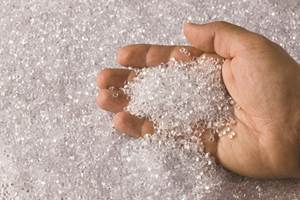Dimensional Stability After Molding: Part 1
The degree to which molded parts shrink as they cool is largely dependent upon the composition of the material being processed.
Everyone involved in plastics processing knows that molded parts shrink as they cool. The degree to which this occurs is largely dependent upon the composition of the material being processed. Semi-crystalline materials shrink more than amorphous ones, and fillers will reduce the shrinkage rate of any particular polymer to a degree that depends upon the type and amount of filler that is added.
Part geometry is also a contributing factor—thin-walled parts shrink less than products with thicker walls simply because they cool to an equilibrium state more quickly. Processing conditions also have an influence on this behavior. Higher packing pressures will reduce the level of shrinkage, and lower mold temperatures also have this effect, although in the case of mold temperature the benefits may be only temporary.
One of the most difficult aspects of constructing a mold is determining the compound effects of all these factors on the relationship between the tool dimensions and the size of the related part features.
While everyone accepts shrinkage as a fact of life, there is somewhat less agreement regarding the time frame required for a part to become dimensionally stable. This is of practical importance since dimensional checks are part of first-article approval procedures, process-capability studies, and ongoing quality checks during production runs.
Measurements made too early will provide bad data, but waiting longer than necessary creates the risk that corrective actions made to a process that is out of specification will come too late. Efforts to produce parts to print often make use of tools known as hot gauges. These are go/no-go devices that can be used to check a part that is still in the process of cooling and shrinking but has reached a point where the final dimension can be accurately predicted based on an established relationship between the dimension of the hot part and the final dimension of the stable product.
Studying the process of shrinkage in any given part produces a relationship between size and time that follows a function known as exponential decay. When plotted on a linear scale this produces a graph such as the one on this page. The dimensions drop rapidly in the first few minutes and the rate of change becomes slower as the part approaches equilibrium. Eventually, no further changes are noted and the part is considered to be stable. A comparison of the controlling tool dimension and the final size of the part will produce an actual value for the mold shrinkage.
It is an interesting exercise to compare this actual value with the published values for mold shrinkage on the material data sheet. In the case of the part in the accompanying graph, the material was an unfilled PBT with a published mold shrinkage value of 0.017-0.023 in./in. The critical dimension on the part print is given as 4.941 + 0.008 in., and the actual mold shrinkage value for a part molded to the nominal dimension is 0.02197 in./in.
The critical parameter in making a good prediction of the final part size is the time required for the curve to flatten out. The graph for this part shows that the process of reaching a stable dimension takes 2 hr. This is due to the fact that PBT is a semi-crystalline polymer, this particular grade contains no fillers or reinforcements that can limit the shrinkage of the polymer, and the nominal wall of this part is 0.250 in., so the cooling process is relatively slow. The cycle time for this part is 60 sec, so if the part is running out of specification, waiting 2 hr before making a correcting adjustment will cause the rejection of 120 parts. The ability to correlate the size of the part at 15 to 20 min, when the curve has “turned the corner,” to that of the final part can save hundreds or even thousands of rejected parts over the course of a year.
But is the time frame to complete shrinkage 2 hr for all parts and material types? As it turns out, it is not. The actual time required to reach dimensional stability will depend upon all of the factors mentioned above. For thin-walled parts molded in amorphous materials, the wait time may be as little as 15 min and even parts with wall thickness of 0.125 to 0.140 in. will be stable in half an hour. Most molded parts are stable within an hour. But there are maddening exceptions.
First, part size is important. Mold shrinkage is a percentage of the as-molded dimension. A mold shrinkage of 0.010 in./in. is equal to a 1% dimensional change. Often our judgment of stability is indexed to what we can measure. If we are using tools that have a resolution down to 0.001 in., then a part with a critical dimension of 1 in. will appear to have reached a stable condition before a part with a critical dimension of 20 in. simply because a last 0.001 in./in. change will barely be detected in the smaller part and will likely be only a small percentage of the total print tolerance, while in the larger part this same percentage change may equal the entire tolerance range.
Parts with very thick walls present some significant challenges simply because the time required for the entire part to cool is extended. This is particularly problematic for unfilled semi-crystalline materials, where shrinkage is related to the process of crystallization. Crystals are well-ordered regions and consequently occupy less space than the amorphous regions. With increasing degrees of crystallinity come increased levels of shrinkage.
If you want to get a feel for the magnitude of this relationship, refer to a data sheet for PEEK. This polymer is slow to crystallize and therefore can be produced in either an amorphous or a semi-crystalline structure depending upon the cooling rate. The density for amorphous PEEK is 1.26 g/cc while for the semi-crystalline variety it is 1.30 g/cc. This is a 3.2% difference and can translate to as much as a 0.015 in./in. difference in shrinkage in all directions.
But even with a typical wall thickness there are semi-crystalline materials that do not seem to follow the rules. Parts molded in these materials appear to keep changing for an extended period of time—days, not hours. And while most of these changes involve the part becoming smaller, there are instances where part size increases. The reasons for this seemingly anomalous behavior, and how to best cope with the associated challenges, will be the subject of Part 2.
About the Author
Michael Sepe is an independent materials and processing consultant based in Sedona, Ariz. with clients throughout North America, Europe, and Asia. He has more than 35 years of experience in the plastics industry and assists clients with material selection, designing for manufacturability, process optimization, troubleshooting, and failure analysis. Contact: (928) 203-0408 • mike@thematerialanalyst.com.
Editor’s note: You can read the next part in the series by clicking here.
Related Content
Tracing the History of Polymeric Materials -- Part 30: Polyurethane
In the world of polymers, polyurethane chemistry is probably the most versatile. This a resulted in a wide range of products made from these materials and given the industry the flexibility to respond to the progressive march of regulatory concerns.
Read MoreFundamentals of Polyethylene – Part 3: Field Failures
Polyethylene parts can fail when an inappropriate density is selected. Let’s look at some examples and examine what happened and why.
Read MoreFundamentals of Polyethylene – Part 5: Metallocenes
How the development of new catalysts—notably metallocenes—paved the way for the development of material grades never before possible.
Read MoreThe Effects of Stress on Polymers
Previously we have discussed the effects of temperature and time on the long-term behavior of polymers. Now let's take a look at stress.
Read MoreRead Next
People 4.0 – How to Get Buy-In from Your Staff for Industry 4.0 Systems
Implementing a production monitoring system as the foundation of a ‘smart factory’ is about integrating people with new technology as much as it is about integrating machines and computers. Here are tips from a company that has gone through the process.
Read MoreSee Recyclers Close the Loop on Trade Show Production Scrap at NPE2024
A collaboration between show organizer PLASTICS, recycler CPR and size reduction experts WEIMA and Conair recovered and recycled all production scrap at NPE2024.
Read More
.jpg;width=70;height=70;mode=crop)



















